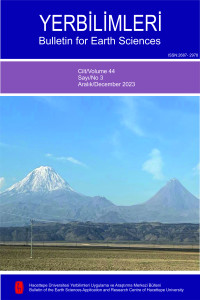Numerical simulation of the effects of the fault dip angle and permeability contrast on heat transfer and Fluid flow in Geothermal sites
Öz
The presence of faults/fractures in geothermal fields significantly affects the distribution of fluid flow and temperature. This effect is more dominant especially in areas with dense faulting. Previous studies discussed the effects of the presence of faults and permeability contrast between faults and surrounding geological units on fluid flow. In order to investigate this phenomenon, numerical methods are unique since they include physical and hydraulic parameters of the medium. In this study, the temperature pattern and groundwater flow due to the dip angle of the fault and permeability contrast were explored by various test models. We used finite volume based Computational Fluid Dynamic (CFD) Software, ANSYS Fluent, for numerical modeling. The results of the numerical simulations indicate that, although the dip angle of the fault can slightly modify the fluid vectors and temperature distribution, the main determining factor is the permeability contrast. This study can be used and expand as a preliminary study to predict the possible paths of fluid, in extensively faulted geothermal fields.
Anahtar Kelimeler
Fay permeabilite sıvı akışı sayısal modelleme ısı geçişi jeotermal Hesaplamalı Akışkanlar Dinamiği (HAD)
Kaynakça
- Antonellini, M., & Aydin, A., 1994. Effect of faulting on fluid flow in porous sandstones: Petrophysicial properties: Amer- ican Association of Petroleum Geologists Bulletin, v. 78, p. 355–377. DOI: 10.1306/bdff90aa-1718-11d7- 8645000102c1865d
- Başokur, A. T., Koçyiğit, A., Hacıoğlu, Ö., Arslan, H. İ., & Meqbel, N., 2022. Magnetotelluric imaging of the shallow- seated magma reservoir beneath the Karadağ stratovolcano, Central Anatolia, Turkey. Journal of Volcanology and Geothermal Research, 427, 107567. DOI: 10.1016/j.jvolgeores.2022.107567
- Caine, J. S., Forster, C. B., and Evans, J. P., 1993. A classification scheme for permeability structures in fault zones. Eos (Transactions, American Geophysical Union), v. 74, p. 677.
- Cherubini, Y., Cacace, M., Blöcher, G., & Scheck-Wenderoth, M., 2013. Impact of single inclined faults on the fluid flow and heat transport: Results from 3-D finite element simulations. Environmental Earth Sciences, 70(8), 3603–3618. DOI: 10.1007/s12665-012-2212-z
- Düşünür Dogan, D. , Ocakoğlu Gökaşan, N., Tinivella, U. ,Giustiniani, M, Turkdogan, S., Arık, S. & Altan, Z., 2022. Modeling the time-dependent dissolution of Gas Hydrates in the South Shetland Islands, Antarctica.
JEOTERMAL SAHALARDA FAYLARIN EĞİMİNİN VE PERMEABİLİTE KONTRASTININ SICAKLIK VE AKIŞ DAĞILIMINA ETKİSİNİN SAYISAL MODELLENMESİ
Öz
Jeotermal sahalarda fayların/kırıkların varlığı, jeotermal akışkanın ve sıcaklığın dağılımını önemli ölçüde etkilemektedir. Özellikle yoğun faylanmanın olduğu sahalarda bu etki daha fazla ön plana çıkmaktadır. Daha önceki çalışmalar, fayların varlığının ve fay ile ortam arasındaki permeabilite farkının, akışkan hareketi üzerine olan etkilerini tartışmıştır. Bu etkinin anlaşılabilmesi için seçilebilecek yöntemlerin başında, pek çok fiziksel ve hidrolik parametreyi kapsayan sayısal modelleme çalışmaları gelmektedir. Bu çalışmada, fayların eğimlerinin ve fay-civar kayaçlar arası permeabilite kontrastının neden olduğu sıcaklık dağılımı ve yeraltısuyu akış dağılımı farklı test modeller oluşturularak incelenmiştir. Sayısal modelleme için Hesaplamalı Akışkanlar Dinamiği (HAD) programı olan ve sonlu hacimler prensibi ile çalışan ANSYS Fluent yazılımı kullanılmıştır. Test modellerinin sonuçları, fay açısı değişiminin, sıcaklık dağılımını ve hız vektörlerinin yönünü bir miktar etkilese de, esas belirleyici faktörün permeabilite kontrastı olduğunu göstermektedir. Bu çalışma, yoğun faylanmanın olduğu jeotermal sahalarda, akışkanın olası yollarını kestirebilmek için bir ön çalışma olarak uygulanabilir ve geliştirilebilir.
Anahtar Kelimeler
Fay permeabilite sıvı akışı sayısal modelleme ısı geçişi jeotermal Hesaplamalı Akışkanlar Dinamiği (HAD)
Destekleyen Kurum
İstanbul Teknik Üniversitesi
Teşekkür
Bu çalışma, İstanbul Teknik Üniversitesi Lisansüstü Eğitim Enstitüsü desteği ile gerçekleştirilmiştir. Çalışmada kullanmış olduğumuz modellerin, ilk oluşturulmasında emeği olan Merhum Yük. Müh. Serkan Üner’i rahmetle anıyoruz.
Kaynakça
- Antonellini, M., & Aydin, A., 1994. Effect of faulting on fluid flow in porous sandstones: Petrophysicial properties: Amer- ican Association of Petroleum Geologists Bulletin, v. 78, p. 355–377. DOI: 10.1306/bdff90aa-1718-11d7- 8645000102c1865d
- Başokur, A. T., Koçyiğit, A., Hacıoğlu, Ö., Arslan, H. İ., & Meqbel, N., 2022. Magnetotelluric imaging of the shallow- seated magma reservoir beneath the Karadağ stratovolcano, Central Anatolia, Turkey. Journal of Volcanology and Geothermal Research, 427, 107567. DOI: 10.1016/j.jvolgeores.2022.107567
- Caine, J. S., Forster, C. B., and Evans, J. P., 1993. A classification scheme for permeability structures in fault zones. Eos (Transactions, American Geophysical Union), v. 74, p. 677.
- Cherubini, Y., Cacace, M., Blöcher, G., & Scheck-Wenderoth, M., 2013. Impact of single inclined faults on the fluid flow and heat transport: Results from 3-D finite element simulations. Environmental Earth Sciences, 70(8), 3603–3618. DOI: 10.1007/s12665-012-2212-z
- Düşünür Dogan, D. , Ocakoğlu Gökaşan, N., Tinivella, U. ,Giustiniani, M, Turkdogan, S., Arık, S. & Altan, Z., 2022. Modeling the time-dependent dissolution of Gas Hydrates in the South Shetland Islands, Antarctica.
Ayrıntılar
| Birincil Dil | Türkçe |
|---|---|
| Konular | Mühendislik |
| Bölüm | Makaleler |
| Yazarlar | |
| Yayımlanma Tarihi | 29 Aralık 2023 |
| Gönderilme Tarihi | 3 Ocak 2023 |
| Kabul Tarihi | 23 Kasım 2023 |
| Yayımlandığı Sayı | Yıl 2023 Cilt: 44 Sayı: 3 |

